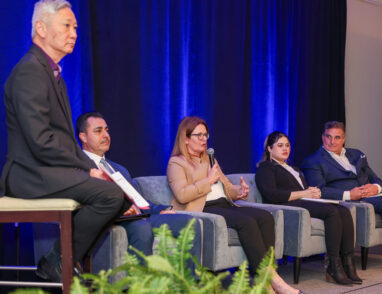Strengthening Care for Vulnerable Populations with Quality Measures
April 12, 2018 · Jessica Briefer French
 Across the country, budget shortfalls have put pressure on state Medicaid programs that provide most publicly funded long-term service and supports (LTSS). Simultaneously, many people are unprepared for the expenses related to vulnerable populations and their probable need for LTSS.
Across the country, budget shortfalls have put pressure on state Medicaid programs that provide most publicly funded long-term service and supports (LTSS). Simultaneously, many people are unprepared for the expenses related to vulnerable populations and their probable need for LTSS.
People’s strong preference for aging in place and the growing need for states to save money on institutional care have fueled a variety of federal initiatives to “rebalance” from institutional care to home- and community-based services (the Affordable Care Act created new opportunities for states to shift long-term care from institutions to the community). State Medicaid programs have taken
advantage of financial incentives and used federal waivers to provide more LTSS in people’s homes and communities. And, increasingly, states also are moving from fee-for-service to managed care for LTSS delivery.
LTSS delivery is shifting to capitated managed care arrangements as state Medicaid programs seek to increase accountability, improve quality and promote a cost-effective service delivery system that integrates care across all services—medical, behavioral, social and LTSS. Meeting these goals requires new skills, infrastructure and processes for managed care organizations (MCO) and community-based organizations (CBO).
A variety of organizations are responsible for arranging for LTSS, including traditional MCOs, managed LTSS-only health plans and CBOs such as Aging and Disability Resource Centers and area agencies on aging (AAA). Traditional MCOs are broadening their focus from a purely medical model to provide functional and social supports (e.g., by partnering with CBOs, which have long been responsible for arranging for those services).
Measurement and Evaluation Can Help High-Need Populations
In 2010, The SCAN Foundation, concerned about the quality of care for people with dual eligibility or who need LTSS, asked the National Committee for Quality Assurance (NCQA) to research how to apply measurement and evaluation to better address the challenges facing high-needs populations.
NCQA’s LTSS Accreditation programs help MCOs and CBOs work together in this changing landscape to provide person-centered, integrated care for people with complex needs and to ensure that organizations offering LTSS safeguard patients’ rights and continuously improve quality. When considering measuring quality for individuals with complex needs, NCQA strove to keep the person at the center of the critical processes of assessment and care planning.
NCQA has followed two tracks. The first involves working with organizations to build the structures and processes they need to deliver person-centered care and services, and to generate the data required to calculate quality measures. Part of this capacity-building work is NCQA’s accreditation program, launched in July 2016, and the Roadmap to Success in LTSS (goo.gl/nKX6Mj), a compendium of practical “how-to” examples. The second track involves developing measures of person-centered outcomes: measures based on what is important to individuals.
National reviews of quality measures have found very few that address the primary concerns of older adults and people who use LTSS. For people with complex needs, “quality” means medical care and LTSS that are designed and executed to address their priorities, such as maintaining independence and decision-making autonomy, living in their own homes, interacting with friends and family or staying out of the hospital.
With The SCAN Foundation’s support, NCQA developed a framework for measuring LTSS quality and drafted standards for integrated care. The framework (see figure, above) describes an infrastructure that underpins the clinical care process and comprises quality improvement systems, effective population management, health information technology and beneficiary engagement and rights. Clinical care and services begin with screening and assessing a person’s strengths, resources, needs and goals.
Screening and assessment inform an individualized care or service plan that is shared with the interdisciplinary care team, which uses it to coordinate care and services—ultimately resulting in achievement of the quadruple aim: healthy people, healthy communities and better and more affordable care.
With support from The SCAN Foundation and The John A. Hartford Foundation, NCQA has undertaken a series of projects to develop measures for quality improvement and accountability. But before national measures can be implemented, organizations caring for the dual eligible and LTSS populations must be able to deliver care and services efficiently and to demonstrate their effectiveness through data and quality measures. NCQA’s early work found that many organizations require significant capacity-building to fulfill this requirement.
Putting Accreditation to Work
On June 13, 2017, Aging & In-Home Services of Northeast Indiana, Inc. (AIHS), the AAA for Northeast Indiana, became the first CBO to earn NCQA Accreditation of Case Management for LTSS.
“We’ve been working in the integrated care space for about four-and-a-half years, and as we look forward, we see the importance of having an accreditation that is recognized by the medical community,” said AIHS President and CEO Connie Benton Wolfe. Wolfe credits LTSS accreditation with making rigorous standards part of the AIHS culture.
“Accreditation is not aspirational, it’s essential,” she says.
“I think that can only strengthen us, because it means that as we’re going through the accreditation process, we’re engaging members at all levels of our staff,” she adds.
One key area to which AIHS applied LTSS standards was its care transitions process. When a case manager visits a client in his or her home after discharge from a hospital or care facility, AIHS communicates with physicians via an emailed letter. AIHS believes the improved transition communication process has made case managers more visible to the medical community and has helped integrate services. Since implementing this policy, there have been several instances in which the emailed letter reported medical changes. For example, a client was unable to communicate with her primary care physician about an issue with her colostomy. The transition letter allowed the physician to respond quickly with treatment options, preventing further complications.
The new process also yielded positive outcomes for individuals with dementia. During a visit with her case manager, a client reported that she was becoming more forgetful. The case manager learned that the client was not storing food properly, did not know how to take her medications and had asked her in-home care staff to take her to the store when she was wearing slippers and a robe. After detailing this information in the transition letter and emailing it to the client’s physician, the case manager and the physician collaborated to increase the client’s services, schedule follow-up appointments and work with the family caregiver to manage medications.
To improve overall care and support people to live optimally within their preferred setting, organizations that coordinate LTSS should implement best practices for delivering person-centered care planning and effective care transitions, and for measuring quality improvement.
“We’re familiarizing our staff with those attributes of person-centered care and the standardization that comes with it. It’s not taking us in a new direction, but it brings a new level of structure to our agency that will only make us stronger,” says Benton Wolfe.








